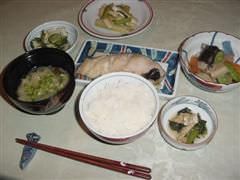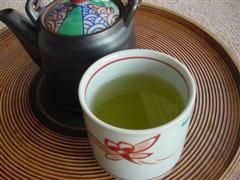|
Japan has one of the lowest rates of obesity in the world--less than 5 percent, compared to nearly 35 percent for the United States. How do the Japanese stay so slim? Journalist Alice Gordenker (USAGITWO) blogs in from Tokyo to share Japanese diet and health secrets – ones you too can use!
Japanese Secret #1: Eat 30 Different Foods Every Day In Japan, the standard nutritional advice is to eat 30 different foods every day. The idea is that building a diet of so many different foods pretty much guarantees that you’ll get a balanced diet and all the nutrients you need. For someone building a meal the Japanese way, with many dishes in tiny portions, this is an achievable goal. A typical Japanese dinner at home might be a small serving of protein like teriyaki chicken or grilled fish, two or three vegetable-based mini-entrées, salty pickles made from seasonal vegetables, a bowl of rice and miso soup with two or three goodies like little cubes of tofu, a clam or two, chopped scallions etc. On a standard Western diet, however, it’s tough to clock in 30 foods a day. Let’s see: Muffin for breakfast, ham-and-cheese sandwich with lettuce and tomato for lunch; steak, potatoes and broccoli for dinner--why, that’s only 9 items! To build your way to 30, try adding two mini-sides of vegetables or fruit with every meal, even breakfast! There’s no reason you can’t add a little salad to your morning. Japanese people do, all the time.  Japanese Secret #2: Make it Look Good Food that looks good is more satisfying, and the Japanese have famously made an art out of food presentation. This is one reason Japanese are less likely to overeat. In Japan, the emphasis is never on filling a plate. In fact, it’s considered better to leave some empty space so the design of the plate can complement the food and make it look better. It’s also considered important to arrange food so it’s not all flat on the plate. That gives a sense of depth and makes the food look more appealing. Having a range of colors is vital, too, both in the dishes and in the food. You don’t have to hire a Japanese consultant to plate every meal you cook, but try taking more care in presentation and see if you feel more satisfied with less food. Instead of slapping the whole slab of swordfish flat on your plate, try cutting it into two or three pieces and placing them so they overlap in a pleasing pattern. Add color with a cherry tomato and sautéed green and yellow peppers. And always take a minute before you start to feast only with your eyes. Japanese Secret #3: Chew Every Bite Well I know, I know--your grandmother used to say the same thing. But this little piece of wisdom turns up all the time in diet tips in Japan. The explanation is that taking the time to really chew not only slows you down so you eat less, but also that the physical act of moving your jaw sends signals to the brain so you feel satisfied faster. (As an aside, it’s also a common belief in Japan that chewing makes kids smarter, so you have to give kids foods that require some effort to chew.) Japanese Secret #4: Drink Green Tea Scientists are still unraveling the many ways in which green tea is good for your health. There’s mounting evidence that green tea can do everything from warding off Alzheimer’s to protecting you from cancer. In Japan, it’s not unusual for people to drink five or six cups of green tea a day. Is there a connection between all that tea drinking and low rates of obesity? Probably. Compounds in green tea have been shown to reduce cholesterol and speed up the metabolism of fat. I drink several cups of green tea every day. To honest, I don’t think too much about the science and the health claims. In terms of weight loss, I just apply common sense: green tea has no calories and no fat. So of course it’s a better choice than sugary sodas and calorie-packed coffee drinks. And I really enjoy it.  Japanese Secret #5: Walk 10,000 Steps Every Day Sound like a lot? It is--at my stride, 10,000 steps works out to 7.8 kilometers or a little under 5 miles. If you can’t imagine fitting a 5-mile walk into your busy day, don’t worry. Your steps count even when you’re walking down the hall to a co-worker’s office or pushing the cart at the supermarket. Here in Japan, people get a fair amount of activity in their daily lives. Levels of car ownership are lower than in other developed countries, and people are more likely to walk, bike or take public transportation. Still, it takes some consciousness to hit 10,000 steps, which is why pedometers are so popular here. There is even a step-counting feature in many mobile phones. 
If you want to give this a try, use a pedometer or step-counter to see how much you’re already moving. Then increase your count little by little, with simple steps like getting off the bus a stop earlier or adding a ten-minute walk in the evening. Did you know that you can add a step-tracker to your My Fitness page? And the default setting is 10,000 steps! Thanks in part to good habits picked up in Japan, Alice Gordenker (USAGITWO) maintained a healthy body weight for her first 10 years in the country. But when a gradual gain suggested the onset of Dreaded Middle-Age Spread, Alice took action by joining SparkPeople. She started with the Nutrition Tracker to get a reality check on portion size and overall food intake, and was pleasantly surprised to find lots of Japanese foods already entered in the database by other members. She’s now reached her goal but still logs in daily for motivation and to use the Fitness Tracker. The Map My Route feature works even in Tokyo! Check out her columns in The Japan Times. Which of these tips is the most helpful to you? Do you eat Japanese foods at home? |
Popular EntriesMore From SparkPeople
|













